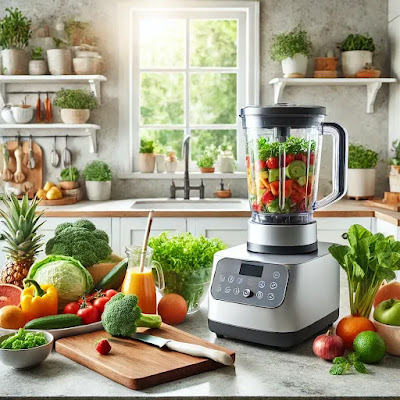10 Essential Kitchen Tools and Equipment to Simplify Your Daily Cooking
Routine
See Also: AI and Sustainability: How Technology is Driving Eco-Friendly Innovations in Next Decade
Cooking at home is one of the best ways to eat healthier, save money, and
bond with loved ones. However, it can sometimes feel daunting, especially if
you lack the right tools. Having the proper kitchen gadgets and equipment can
simplify tasks, save time, and make cooking a more enjoyable experience.
In this blog, we’ll explore 10 essential kitchen tools and equipment
that every home cook should have. These items are not only practical but also
versatile, ensuring that you can tackle a wide variety of recipes with ease.
1. Chef’s Knife
A sharp, high-quality chef’s knife is the backbone of any kitchen. This
all-purpose knife is perfect for slicing, chopping, and dicing vegetables,
fruits, and proteins.
- · Why it’s essential: A good chef’s knife saves time and effort, providing precision and comfort for all cutting tasks.
- · What to look for: Choose a knife with
a well-balanced weight and an ergonomic handle. High-carbon stainless steel
blades are ideal for durability and sharpness.
·
Pro tip: Keep your knife sharp with a
honing rod or sharpening stone for optimal performance.
- Pair your chef’s knife with a sturdy cutting board to protect your countertops and knives.
- Why it’s essential: Cutting boards provide a safe and hygienic surface for food preparation.
Types to consider:
- Wooden cutting boards are gentle on knives and ideal for dry ingredients.
- Plastic boards are dishwasher-safe and
great for raw meats to avoid cross-contamination.
· Pro tip: Have separate boards for
meat, vegetables, and bread to prevent flavor transfer.
A non-stick frying pan is a versatile tool for cooking everything from
eggs to pancakes and stir-fries.
- · Why it’s essential: Non-stick surfaces prevent food from sticking and reduce the need for excess oil, making cooking healthier and cleanup easier.
- ·
What to look for: opt for a durable
pan with a PFOA-free coating for safety. Choose a size that suits your cooking
needs (8-inch or 10-inch are popular choices).
·
Pro tip: Avoid using metal utensils on
non-stick pans to prolong their life.
Precision is key in cooking and baking, and measuring tools ensure you
get your recipes right every time.
- · Why it’s essential: They help you measure ingredients accurately, especially when following recipes that require specific proportions.
- ·
What to look for: Choose sturdy
stainless steel or BPA-free plastic sets. Look for clearly labeled measurements
for ease of use.
·
Pro tip: Have separate measuring tools
for dry and liquid ingredients for better accuracy.
5. Mixing Bowls
A set of mixing bowls is indispensable for combining ingredients,
marinating, or serving salads.
- · Why it’s essential: These bowls come in handy for a variety of tasks, from whisking eggs to mixing dough.
- ·
What to look for: Stainless steel,
glass, or BPA-free plastic options are durable and versatile. Nesting sets save
space in your kitchen.
·
Pro tip: Use bowls with non-slip bases
to keep them steady during vigorous mixing.
See Also: Affordable Fitness Trackers: The Best Budget Picks for Monitoring Your Health
Blenders and food processors simplify tasks like pureeing soups, making
smoothies, or chopping vegetables.
- ·
Why it’s essential: These appliances
save time and effort for both simple and complex recipes.
·
What to look for:
- · For smoothies and soups, a high-speed blender works best.
- ·
For chopping and shredding, a
multi-functional food processor is ideal.
·
Pro tip: Invest in a model with
multiple speed settings and dishwasher-safe components for convenience.
A durable baking sheet is perfect for roasting vegetables, baking
cookies, or preparing sheet pan dinners.
- · Why it’s essential: It ensures even cooking and easy cleanup, thanks to its non-stick surface or the use of parchment paper.
- ·
What to look for: Heavy-duty aluminum
or stainless-steel pans with a rimmed edge to prevent spills.
·
Pro tip: Line your baking sheet with
aluminum foil or parchment paper for quicker cleanup.
8. Colander
A colander is a must-have for draining pasta, rinsing vegetables, and
washing fruits.
- · Why it’s essential: It makes draining water simple and keeps your hands safe from burns.
- ·
What to look for: Choose a stainless
steel or BPA-free plastic colander with sturdy handles and feet for stability.
·
Pro tip: Use a fine-mesh sieve as a
multipurpose alternative for straining smaller particles like quinoa or sifting
flour.
A slow cooker or Instant Pot is a game-changer for busy cooks, offering a
hands-free way to prepare meals.
- · Why it’s essential: These devices allow you to cook stews, soups, and even desserts with minimal effort.
- ·
What to look for: Choose a model with
multiple functions (e.g., pressure cooking, sautéing, and steaming) for
versatility.
·
Pro tip: Use a programmable timer to
have your meal ready exactly when you need it.
Silicone spatulas are flexible, heat-resistant, and perfect for scraping,
mixing, and folding ingredients.
- · Why it’s essential: They prevent scratching non-stick pans and are easy to clean.
- ·
What to look for: Look for
BPA-free, heat-resistant silicone that can withstand high temperatures.
·
Pro tip: Keep various sizes and
shapes to handle different kitchen tasks.
See Also: Upgrade Your Living Space: Top 10 Smart Home Gadgets You Need in 2025 Featuring the Best Smart Devices for Home
Bonus Tips for Building Your Kitchen Arsenal
- Start Small: If you’re
just starting out, focus on multipurpose tools that cover a wide range of
tasks.
- Invest Wisely: While
some tools may have a higher upfront cost, quality equipment lasts longer
and performs better.
- Organize Your
Kitchen: Keep your tools easily accessible by using drawer organizers,
hooks, or shelves.
Conclusion
With these 10 essential kitchen tools and equipment, you can transform
your cooking experience from stressful to seamless. Whether you’re a beginner
or a seasoned cook, these items will help you prepare meals more efficiently
and with less hassle.
Investing in the right tools is a small step toward creating a kitchen
you love and inspiring your culinary creativity. Ready to upgrade your cooking
game? Start with these essentials and see the difference they make in your
daily routine!
FAQs
Q1. What are the must-have kitchen tools for beginners?
For beginners, focus on multipurpose tools like a chef’s knife, cutting
board, mixing bowls, measuring cups and spoons, and a non-stick frying pan.
These basics will cover most cooking needs without overwhelming you.
Q2. How do I choose high-quality kitchen tools?
Look for durable materials like stainless steel or high-carbon steel for
knives and utensils. Read reviews, test for comfort (like ergonomic handles),
and prioritize reputable brands with good warranties.
Q3. Can I buy affordable kitchen equipment that lasts?
Yes! Many budget-friendly brands offer durable and functional kitchen
tools. Focus on the essentials first and upgrade as needed. Discount stores and
online sales are great places to find deals.
Q4. How should I maintain my kitchen tools?
- Knives: Sharpen
them regularly and wash them by hand to maintain their edge.
- Non-stick pans: Avoid
metal utensils and clean them gently.
- Wooden tools: Handwash
and occasionally oil them to prevent drying or cracking.
- Appliances: Clean them
after each use and store them properly to extend their life.
Q5. What tools can I use to save time in the kitchen?
Tools like blenders, food processors, Instant Pots, and slow cookers are
great for saving time. Additionally, gadgets like garlic presses and mandolins
can speed up prep work.
Q6. Is it necessary to buy separate cutting boards for different foods?
Yes, it’s a good idea to use separate boards for raw meat, vegetables,
and bread to avoid cross-contamination and maintain food safety.
Q7. Are silicone tools safe for cooking?
Yes, high-quality, BPA-free silicone tools are safe for cooking. They’re
heat-resistant and gentle on non-stick cookware, making them reliable.
Q8. How often should I replace kitchen tools?
Replace tools with signs of wear, such as dull knives, warped cutting
boards, or scratched non-stick pans. Proper maintenance can extend their
lifespan.
Q9. Can I cook without expensive tools?
Absolutely! While high-end tools can enhance your experience, many
affordable options work just as well for everyday cooking. Focus on
functionality rather than price.
Q10. Where can I store kitchen tools in a small kitchen?
Use wall-mounted racks, magnetic knife strips, or stackable storage
containers to save space. Drawer organizers and nesting tools are also
excellent for maximizing limited storage.





.webp)
